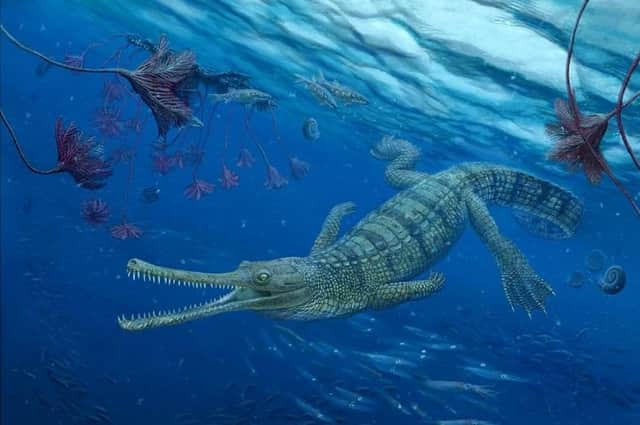Edinburgh University researchers discover new species of ancient crocodile from fossils


Despite 300 years of research, and a recent renaissance in the study of their biological make-up, the mysterious, marauding teleosauroids have remained elusive.
Scientific understanding of this distant cousin of present day long-snouted gharials has been hampered by a poor grasp of their evolutionary journey until now.
Advertisement
Hide AdAdvertisement
Hide AdTheir analysis offers glimpses of how teleosauroids adapted to the momentous changes that occurred during the jurassic period, as the earth’s seas experienced many changes in temperature.
Dr Michela M. Johnson, study lead at the School of GeoSciences at the University of Edinburgh said: “Our study just scratches the surface of teleosauroid evolution but the findings are remarkable, raising interesting questions about their behaviour and adaptability.
"These creatures represented some of the most successful prehistoric crocodylomorphs during the Jurassic period and there is so much more to learn about them.”
The study reveals that not all teleosauroids were engaged in cut and thrust lifestyles, snapping at other reptiles and fish from the seas and swamps near the coast.
Advertisement
Hide AdAdvertisement
Hide AdInstead, they were a complex, diverse group that were able to exploit different habitats and seek out a variety of food sources.
Previous research had provided insights into the origins and evolution of this fossilised croc’s whale-like relatives, but less was known about teleosauroids.
The expert team of palaeontologists examined more than 500 fossils from more than 25 institutions around the world.
Cutting edge software enabled the team to glean swathes of data regarding their anatomical similarities and differences, by examining the entire skeleton, teeth and bony armour, which indicated whether species were closely related or not.
Advertisement
Hide AdAdvertisement
Hide AdThis information enabled the team to create an up-to-date family tree of the teleosauroids group from which emerged two new large groups, whose anatomy, abundance, habitat, geography and feeding styles differ from one another.
The first group, teleosaurids, were more flexible in terms of their habitat and feeding. The second group known as machimosaurids – which included the fearsome turtle crushers, Lemmysuchus and Machimosaurus.
Names given by the team to seven newly described fossils, found in both teleosaurids and machimosaurids, reflect a curious range of anatomical features – among them Proexochokefalos, meaning ‘large head with big tuberosities’ and Plagiophthalmosuchus, the ‘side-eyed crocodile’.
There are hints of their diverse behavioural characteristics and unique locations – Charitomenosuchus, meaning ‘graceful crocodile’ and Andrianavoay, the ‘noble crocodile’ from Madagascar.
Advertisement
Hide AdAdvertisement
Hide AdResearchers have named the newly discovered species, Indosinosuchus kalasinensis, after the Kalasin Province in Thailand, where the fossil – now housed in Maha Sarakham University – was found.
The recognition of the new species shows that at least two were living in similar freshwater habitats during the late jurassic – an impressive feat as teleosauroids were becoming rare during this time.
Professor Steve Brusatte, from the School of GeoSciences said: “The same way family trees of our own tell us about our history, this huge new family tree of teleosauroids clarifies their evolution.
"They were some of the most diverse and important animals in the jurassic oceans, and would have been familiar sights along the coastlines for tens of millions of years.”
A message from the Editor:
Thank you for reading this article. We're more reliant on your support than ever as the shift in consumer habits brought about by coronavirus impacts our advertisers.
If you haven't already, please consider supporting our trusted, fact-checked journalism by taking out a digital subscription.
Comment Guidelines
National World encourages reader discussion on our stories. User feedback, insights and back-and-forth exchanges add a rich layer of context to reporting. Please review our Community Guidelines before commenting.